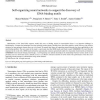301 search results - page 22 / 61 » Reconsidering Network Effect Theory |
NN
2006
Springer
13 years 9 months ago
2006
Springer
Identification of the short DNA sequence motifs that serve as binding targets for transcription factors is an important challenge in bioinformatics. Unsupervised techniques from t...
KDD
2006
ACM
14 years 9 months ago
2006
ACM
Measuring distance or some other form of proximity between objects is a standard data mining tool. Connection subgraphs were recently proposed as a way to demonstrate proximity be...
ICC
2007
IEEE
14 years 3 months ago
2007
IEEE
Abstract— We propose the QoS-driven opportunistic cooperation schemes for the wireless relay networks. By integrating information theory with the concept of effective capacity, o...
GECCO
2009
Springer
14 years 3 months ago
2009
Springer
Problems such as the design of distributed controllers are characterized by modularity and symmetry. However, the symmetries useful for solving them are often difficult to determ...
ICFP
2005
ACM
14 years 9 months ago
2005
ACM
We present a new approach to the old problem of adding side effects to purely functional languages. Our idea is to extend the language with "witnesses," which is based o...

